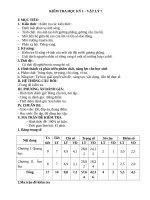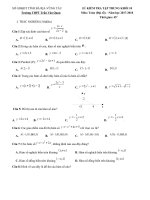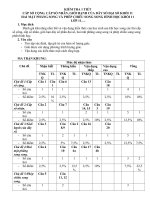listening practice 1 kho học liệu thcs khương đình
Bạn đang xem bản rút gọn của tài liệu. Xem và tải ngay bản đầy đủ của tài liệu tại đây (77.42 KB, 6 trang )
<span class='text_page_counter'>(1)</span><div class='page_container' data-page=1>
<b>Sample: Listening Comprehension Questions</b>
<b>Listen to a teacher or school staff member talking to students. Then answer the question.</b>
<b>Sample Item A</b>
<b>1. What is the subject of the announcement?</b>
1. The school will be adding new classes.
2. Three new teachers will be working at the school.
3. Some students have received an award.
4. The school is getting its own newspaper.
<b>Listen to a teacher or school staff member talking to students. Then answer the question.</b>
<b>Sample Item B</b>
<b>2. What does the teacher want the students to do?</b>
1. Take everything out of their desks
2. Put the painting supplies in plastic bags
3. Bring paints with them to school on Monday
4. Put covers on their desks to keep the paint off
<b>Now you will hear a longer conversation and a teacher talking to a class. Each is followed </b>
<b>by four questions.</b>
<b>Sample Set A</b>
<b>Listen to the conversation</b>
<b>Questions:</b>
<b>3. What are the speakers mainly discussing? Listen</b>
1. A new art project in the city
2. An assignment for their art class
3. An art display inside the public library
4. A painting that the girl saw downtown
<b>4. Why is the boy excited? Listen</b>
1. A famous artist is going to visit his class.
2. His artwork might be seen by many people.
3. His class might visit an art museum.
4. He is getting a good grade in his art class.
<b>5. Where does the boy say he may go this weekend? Listen</b>
1. To the zoo
2. To an art store
3. To Main Street
4. To the public library
</div>
<span class='text_page_counter'>(2)</span><div class='page_container' data-page=2>
2. So that he can sign up for a class trip
3. So that he can see a new painting
4. So that he can talk to the teacher
<b>Sample Set B</b>
<b>Listen to the teacher's talk</b>
<b>Questions:</b>
<b>7. What is the main topic of the talk? Listen</b>
1. A newly discovered type of ant
2. A type of ant with unusual skills
3. An increase in the population of one type of ant
4. A type of ant that could be dangerous to humans
<b>8. According to the teacher, what is one activity that both leafcutter ants and people </b>
<b>do? Listen</b>
1. Clean their food
2. Grow their own food
3. Eat several times a day
4. Feed their young special food
<b>9. What does the teacher say many people think must be true about leafcutter ants? Listen</b>
1. They eat leaves.
2. They live in plants.
3. They have sharp teeth.
4. They are especially large.
<b>10. What did the experiments show about leafcutter ants? Listen</b>
1. How fast they grow
</div>
<span class='text_page_counter'>(3)</span><div class='page_container' data-page=3>
<b>Answer Key for Listening Comprehension:</b>
1. C
2. D
3. A
4. B
5. A
6. D
7. B
8. B
9. A
10. D
<b>Sample Item A</b>
<b>On the recording, you will hear:</b>
<b>(Narrator): Listen to a high school principal talking to the school's students.</b>
<b>(Man):</b>
I have a very special announcement to make. This year, not just one,
but three of our students will be receiving national awards for their
academic achievements. Krista Conner, Martin Chan, and Shriya Patel
have all been chosen for their hard work and consistently high marks.
It is very unusual for one school to have so many students receive this
award in a single year.
<b>(Narrator): What is the subject of the announcement?</b>
<b>In your test book, you will read:</b>
<b>1. What is the subject of the announcement?</b>
1. The school will be adding new classes.
2. Three new teachers will be working at the school.
3. Some students have received an award.
4. The school is getting its own newspaper.
<b>Sample Item B</b>
<b>On the recording, you will hear:</b>
<b>(Narrator): Listen to a teacher making an announcement at the end of the day.</b>
<b>(Man):</b>
</div>
<span class='text_page_counter'>(4)</span><div class='page_container' data-page=4>
<b>(Narrator): What does the teacher want the students to do?</b>
<b>In your test book, you will read:</b>
<b>2. What does the teacher want the students to do?</b>
1. Take everything out of their desks
2. Put the painting supplies in plastic bags
3. Bring paints with them to school on Monday
4. Put covers on their desks to keep the paint off
<b>Sample Set A</b>
<b>On the recording, you will hear:</b>
<b>(Narrator): Listen to a conversation between two friends at school.</b>
<b>(Boy):</b> Hi, Lisa.
<b>(Girl):</b> Hi, Jeff. Hey, have you been to the art room today?
<b>(Boy):</b> No, why?
<b>(Girl):</b>
Well, Mr. Jennings hung up a notice about a big project that's going on
downtown. You know how the city's been doing a lot of work to fix up
Main Street—you know, to make it look nicer? Well, they're going to
create a mural.
<b>(Boy):</b> You mean, like, make a painting on the entire wall of a building?
<b>(Girl):</b> Exactly!
<b>(Boy):</b> But where?
<b>(Girl):</b>
It's that big wall on the side of the public library. And students from
this school are going to do the whole thing ... create a design, and
paint it, and everything. I wish I could be a part of it, but I'm too busy.
<b>(Boy):</b> [excitedly] Cool! I'd love to help design a mural. Imagine everyone in
town walking past that wall and seeing my artwork, every day.
<b>(Girl):</b>
I thought you'd be interested. They want the mural to be about nature,
so I guess all the design ideas students come up with should have a
nature theme.
<b>(Boy):</b> That makes sense—they've been planting so many trees and plants
along the streets and in the park.
<b>(Girl):</b> If you're interested you should talk with Mr. Jennings.
<b>(Boy):</b>
</div>
<span class='text_page_counter'>(5)</span><div class='page_container' data-page=5>
<b>(Girl):</b> [with humor] Well maybe you should go to the art room first to get
more information from Mr. Jennings.
<b>(Boy):</b> [slightly sheepishly] Oh yeah. Good idea. Thanks for letting me know,
Lisa! I'll go there right away.
<b>(Narrator): Now answer the questions.</b>
<b>In your test book, you will read:</b>
<b>3. What are the speakers mainly discussing?</b>
1. A new art project in the city
2. An assignment for their art class
3. An art display inside the public library
4. A painting that the girl saw downtown
<b>4. Why is the boy excited?</b>
1. A famous artist is going to visit his class.
2. His artwork might be seen by many people.
3. His class might visit an art museum.
4. He is getting a good grade in his art class.
<b>5. Where does the boy say he may go this weekend?</b>
1. To the zoo
2. To an art store
3. To Main Street
4. To the public library
<b>6. Why does the girl suggest that the boy go to the art room?</b>
1. So that he can hand in his homework
2. So that he can sign up for a class trip
3. So that he can see a new painting
4. So that he can talk to the teacher
<b>Sample Set B</b>
<b>On the recording, you will hear:</b>
<b>Script Text:</b>
<b>(Narrator): Listen to a teacher talking in a biology class.</b>
<b>(Woman):</b> We've talked before about how ants live and work together in huge
communities. Well, one particular kind of ant community
</div>
<span class='text_page_counter'>(6)</span><div class='page_container' data-page=6>
like farmers. And what do these ants grow? They grow fungi
[FUN-guy]. Fungi are kind of like plants—mushrooms are a kind of fungi.
These ants have gardens, you could say, in their underground nests.
This is where the fungi are grown.
Now, this particular kind of ant is called a leafcutter ant. Because of
their name, people often think that leafcutter ants eat leaves. If they
cut up leaves they must eat them, right? Well, they don't! They
actually use the leaves as a kind of fertilizer. Leafcutter ants go out of
their nests looking for leaves from plants or trees. They cut the leaves
off and carry them underground . . . and then feed the leaves to
the fungi—the fungi are able to absorb nutrients from the leaves. What
the ants eat are the fungi that they grow. In that way, they are like
farmers!
The amazing thing about these ants is that the leaves they get are often
larger and heavier than the ants themselves. If a leaf is too large,
leafcutter ants will often cut it up into smaller pieces—but not all the
time. Some ants carry whole leaves back into the nest. In fact, some
experiments have been done to measure the heaviest leaf a leafcutter
ant can lift without cutting it. It turns out, it depends on the individual
ant. Some are stronger than others. The experiments showed that some
"super ants" can lift leaves about 100 times the weight of their body!
</div>
<!--links-->









